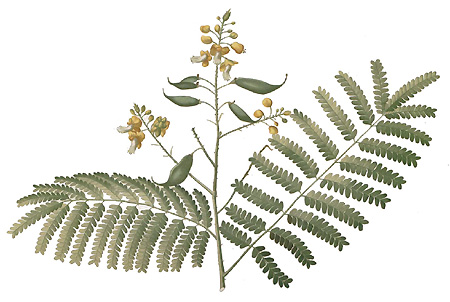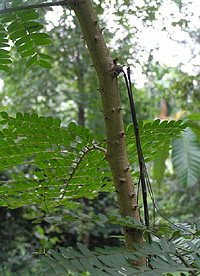
Brazil wood (known as Rotholz, "red wood", in German) is a term generally referring to the wood of tree species of the Caesalpina genus. "Rotholz" is however a term applied to other red woods as well.
Brazil wood species
Sappan wood, also known as East Indian redwood or Japan wood genannt, is the heartwood of a small thorny tree (Caesalpina sappan) which grows to a height 3 to 5 metres. The leaves of the tree are doubly pinnated, and have an elongated oval shape. The flowers are yellow. The tree can also be cultivated. The terms given above are generally applied to Asian Brazil wood species, but the country of origin may vary (Siam, China, Japan, Cochinchina, the Philippines, the Celebes, Java etc.).
True Brazil wood or bahia wood is obtained from the heartwood of the Caesalpina brasiliensis a tree growing in the coastal regions of Brazil.
Pernambuco wood is obtained from the heartwood of a creeper that grows to a height of 10 metres and is native to tropical America (above all in the north of Brazil and in Jamaica). Pernambuco wood is the Brazil wood richest in colourant. Pernambuco is the name of a region in the northeast of Brazil.
Saint Martha wood also known as Nicaraguan wood is obtained from the heartwood of a tree that grows to a height of around 30 metres and bears yellow flowers. The tree is native to the woods of the Sierra Nevada de Santa Marta (Magdalena, in the north of Colombia) and in the Nicoya region on the coast of Nicaragua.
Brasiletto wood, Bahama redwood or Jamaica redwood is obtained in Mexico, Central America, Colombia, Venezuela, Guyana, Jamaica, the Bahamas and the Antilles.

Use and history
The heartwood of the Brazil wood tree yields an important colourant, Brasilin. Extracts are also found to contain another substance, brazilein (C16H12O5). The colourants belong to the neoflavanoid family, and were already used in ancient Peru, by the Mayas and by the Aztecs. Heraclius too, in his De Coloribus et Artibus Romanorum (12th to 13th century) mentions the use of Brazil wood for dyeing and for the production of enamels. Brazil wood or Brazil wood enamel played an important part as a natural organic colourant in the art of occidental book illumination. In the Middle Ages, before America was discovered, Brazil wood generally reached Europe from Eastern India by way of the Great Silk Road. This trade route was cut off when the Turks captured Constantinople in 1453. So in the ensuing period the use of Brazil wood was very restricted. Following the discovery of America, Brazil wood was imported from the new world in great quantities. But as the Brazil wood dye was not light-fast, its use presently declined once more.
Enamels obtained from the Brazil wood have been awarded various designations: garnet enamel, chestnut enamel, dahlia enamel, cochineal enamel (not the real thing) and purple enamel. Differences between the various enamels are to be found in the type of wood, the mordant and any admixtures of organic colourants that may be used. Dissolved in watery coagulants, Brazil wood enamels have been used to dye wallpaper and coloured papers, and they have also found a use in paint pigments and printing. Florentine enamel is a mixture of Brazil wood and carmine; it is used in cosmetics, for facial creams and lipsticks.